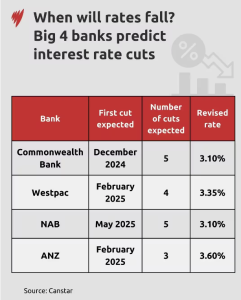When Will Interest Rates Go Down? Big 4 Predictions
Earlier this year, it appeared almost certain that the Reserve Bank of Australia would begin cutting interest rates. However, as we approach the end of 2024, the official cash rate remains steady at 4.35%, unchanged by the Reserve Bank. In its September Board Meeting, the RBA opted for the seventh consecutive time to maintain interest rates at their current level.
Whilst one major bank still holds out hope for a rate cut by year-end, the others remain optimistic that rate first rate cuts will occur in February. By keeping interest rates steady, the RBA has signalled its commitment to further stabilising the economy and maintaining inflation within its target range of 2-3%. This is a good sign for the overall financial health of the country, as stable interest rates help to boost consumer and business confidence, leading to increased spending and investments.
However, many people are still wondering when interest rates will go down.
Whilst interest rates afford home owner and investor mortgage owners a reprieve, they are likely to have a significant impact on the property market. Lower interest rates can result in improved affordability and borrowing ability, stimulating demand for property. With demand already outstripping supply, increased demand can push house prices up even further.

